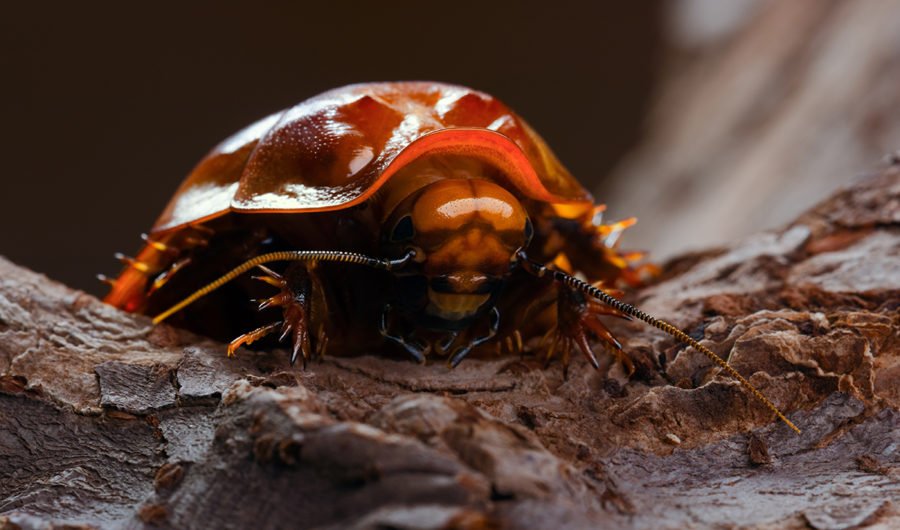Australia’s giant burrowing cockroaches actually hiss

Australia’s native cockroaches are a diverse group of animals. We have the vibrantly coloured Mardi Gras cockroach (Polyzosteria mitchelli), the finely patterned pretty balta (Balta verticalis) and the confusing sun cockroach (Pseudolampra rothei), found only in the Lake Eyre Basin. However, the most fascinating has to be the giant burrowing cockroach (Macropanesthis rhinoceros).
While the giant burrowing cockroach is only the second largest cockroach in the world, it takes out the title for being the world’s heaviest. For University of Sydney cockroach expert Perry Beasley-Hall, holding an insect with any discernible weight is impressive. Throw in its spiked front legs — similar to a mole’s paw— and these cockroaches become even more one-of-a-kind.

A burrowing cockroach’s mole-like front leg. (Image Credit: Perry Beasley-Hall)
Burrow deep
Preferring the dry, sandy scrubland of Far North Queensland, the giant burrowing cockroach digs deep into the soil. “Burrowing roaches can create spiralling burrows of up to six metres long and one metre deep in soil,” Perry says.
At the end of these burrows, the cockroach sets up a type of nursery where they’ll look after their young for up to six months until they’re ready to leave the burrow. Unlike other insects that mostly lay eggs, these cockroaches give birth to live young, meaning they need extra protection.
“It’s actually really uncommon for cockroaches to practice any type of parental care, so this behaviour is unusual as well as being endearing. When they grow up and become adults themselves they can live for up to 10 years,” Perry says.
“Roach parents will also drag dried Eucalyptus leaves into the burrow for their offspring to eat, which amounts to something of a food larder. These roaches are really picky about their diets and will subsist on this kind of leaf for the rest of their lives.”
Bush Heritage Reserve Manager Mat McLean has been working in Reedy Creek, Queensland, for up to 10 years helping to establish a stable environment for the cockroach.
Most of Mat’s work is focussed on good land management practices such as prescribed burning, maintaining the health of trees and controlling weeds. However, there are no immediate threats to burrowing cockroaches. In fact, Mat says, after a big heavy autumn rain event you’ll see them in large numbers.
“In the last two years there have been some bumper crops of them so you couldn’t miss them. Around five years ago there was another good burst,” Mat says.
“It’s a bit sporadic how you see them but when you do see them you usually see lots of them.
“They often get stuck in unnatural land features like deep wheel ruts and so I go along and help fish them out. I’m a bit of a softie that way – I feel compelled to turn them over if I see them on their backs!”

A giant burrowing cockroach burrow.(Image Credit: John Gittoes)
The hissing cockroach
According to Perry, the burrowing cockroach makes a hissing sound by expelling air from its abdomen when it feels threatened.
“They’ll do this when they’re picked up by a person and don’t like it, or when they need to be aggressive and protect their babies.
“They really don’t have any other way of defending themselves aside from their strong armour, so you can imagine they try their best to be loud. To human ears, it comes out very quietly so I think it’s rather cute.”

(Image Credit: Mat McLean/Bush Heritage)
A common pet
That these cockroaches are easy to care for and relatively calm, makes them a common pet.
“I honestly think they’re one of the most approachable insects to have as pets because they aren’t fast-moving or dangerous and can’t fly. For that reason they’re really commonly used in science education and in mini-beast touring shows,” Perry says.
“It’s a great way to get people, particularly kids, more involved with insects and the natural world. That’s actually how I was first introduced to them – through a science outreach program in my primary school.”
READ MORE:
- Our native cockroaches aren’t as gross as you think
- Down and dirty: the Aussie women working in entomology

